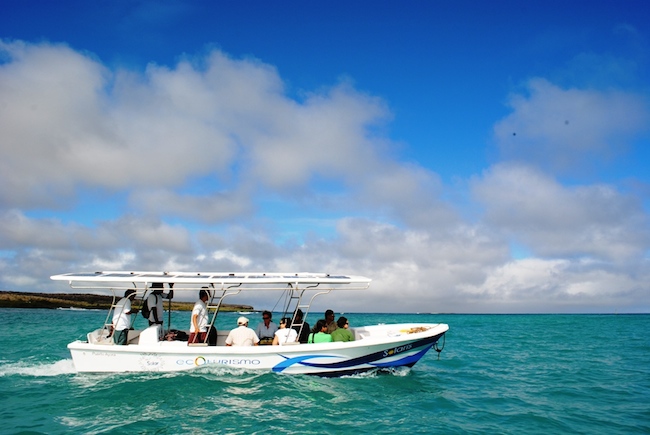
The Solaris, a joint project of World Wildlife Fund and the Galapagos National Park, is one of the only solar powered seagoing vessels in the world and could serve as a model for other solar powered water taxis in the archipelago.
If you are lucky enough to visit the Galapagos Islands, chances are you’ll take a water taxi at some point during your visit. They are the small boats, usually about 20-feet long, that transfer passengers from cruise boats to shore, from one part of an island to another, and even from island to island. With around 200,000 people now visiting the islands each year, demand for water taxi services has never been higher and is expected to keep on growing.
Unfortunately, water taxis are usually retired fishing boats that are powered by outboard motors, which are loud, spew exhaust, guzzle fuel, and spill it into the pristine waters of the Galapagos Marine Reserve. The fuel itself has to be shipped 600 miles from the mainland, which adds to the carbon footprint of the whole endeavor and increases the risk of a major fuel spill within the marine reserve.
Recently, World Wildlife Fund (WWF) and the Galapagos National Park have come up with an innovative solution to the problem. They’ve transformed a boat that the park confiscated from an illegal fishing operation into one of the world’s first fully solar-powered seagoing vessels. The new water taxi, dubbed the Solaris, generates power from eight solar panels affixed to its canopy. The panels power two large lithium batteries and an electric motor, which can propel the Solaris for up to four hours at four knots.
For now, the boat sits in the Galapagos National Park dock on the island of Santa Cruz and is primarily used to teach visitors and locals about the benefits of alternative energy. But the technology it utilizes could eventually help transform the transportation system within the archipelago and go a long way toward solving a considerable problem.
(continued below)
According to estimates provided by Juan Carlos Garcia, WWF’s Galapagos Senior Policy Advisor and Program Manager, there are about 40 water taxis currently operating in the archipelago. Collectively, they use about 30,000 gallons of fuel and spew around 250 tons of CO2 into the atmosphere every year.
Because of the expense of converting a fuel-powered water taxi to a solar one, a solar water taxi trend has yet to take off. Garcia estimates that the photovoltaic system alone (not including solar panels) for a boat the size of the Solaris costs $15,000 to $20,000. Another major obstacle is the huge fuel subsidy the government of Ecuador provides to the Galapagos Islands, which keeps gas prices unnaturally low and reduces the incentive for water taxi owners to make the switch to solar.
Still, Garcia is optimistic, “I think this technological change is inevitable, however, at the moment with the high fuel subsidy there isn´t a real incentive to change to a new technology. I do think it will happen in the next five to seven years as the fuel subsidy is reduced. In the meantime, it’s important to promote pilot projects to educate potential users and stakeholders, and gradually convince them about its viability.”
To help get things moving in the right direction in the meantime, WWF is working with local institutions to create incentives for water taxi operators to adopt the new technology. And Ecuador’s National Institute of Renewable Energies is building a much larger solar-powered vessel to ferry visitors across the Itabaca channel between Baltra, where the major airport is located, and Santa Cruz, which is the most populous and heavily visited island in the archipelago. The four fuel-powered ferries currently in operation shuttle about 146,000 people per year between the islands. The new solar- powered catamaran will replace one of the existing ferries, which consumes an estimated 5,110 gallons of fuel annually and produces five times the legally allowable levels of pollution.
“Innovation is key not only to solving problems,” says Garcia, “but also in giving added value to destinations. Green technologies applied to current tourism practices represent a competitive advantage in a highly competitive global tourism industry. This is of special importance considering that more and more, national and international markets are more knowledgeable about where they travel, and what they expect in terms of environmental standards and practices.”
While the Solaris is certainly a small step in the right direction towards making tourism in the Galapagos more sustainable and environmentally friendly, it could also be a welcome portent of things to come for the tourism industry around the world.
If you’re visiting the Galapagos Islands after November 1st, 2014 and would like to take a spin on the Solaris, contact Mariuxi Farias, WWF´s Tourism Program Officer, at mariuxi.farias@wwf.org.ec.
































